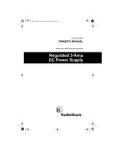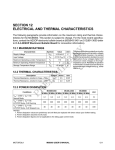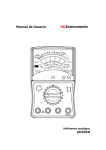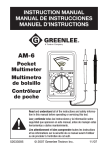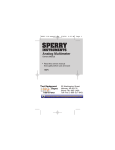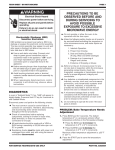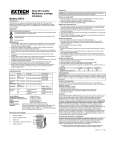Download Radio Shack 62 Owner`s manual
Transcript
22-218.fm Page 1 Friday, August 6, 1999 11:44 AM Cat. No. 22-218 OWNER’S MANUAL Please read before using this equipment. 8-Range Multitester 22-218.fm Page 2 Friday, August 6, 1999 11:44 AM FEATURES Your Radio Shack 8-Range Multitester is a perfect addition to your workshop. It is designed with a precision meter movement to avoid mechanical shock damage. This compact-sized pocket meter accurately measures AC and DC voltages, DC current, and resistance. It also passes the critical safety test required by Underwriters Laboratories for test equipment, and its 2000 ohm/volt sensitivity ensures an accurate reading. © 1995 Tandy Corporation. All Rights Reserved. Radio Shack is a registered trademark used by Tandy Corporation. 2 22-218.fm Page 3 Friday, August 6, 1999 11:44 AM Cautions: • Read this manual completely before you use the meter. • If you are not familiar with meters and testing procedures, we suggest that you read a book about the subject, such as “Using Your Meter” (Radio Shack Cat. No. 62-2039). Note: You need one AA battery (not supplied) to power your multitester. 3 22-218.fm Page 4 Friday, August 6, 1999 11:44 AM A WORD ABOUT SAFETY We have taken every precaution in designing this meter to ensure that it is as safe as possible. But safe operation depends on you, the operator. We recommend that you follow these simple safety rules: • Never apply voltages to the meter that exceed the limits given in the specifications. Never apply more than 1000V DC or AC between any input terminals, or between an input terminal and ground. 4 22-218.fm Page 5 Friday, August 6, 1999 11:44 AM • Use extreme caution when you work with voltages above 40V. Always disconnect power from the circuit you are measuring before you connect test probes to high-voltage points. • Never connect the test probes to a source of voltage when you select the Rx1K W or 150mA DC function. • Always discharge filter capacitors in the power supply of the circuit under test before you attach test probes. • Always turn off power and disconnect the test leads before you replace the batteries. 5 22-218.fm Page 6 Friday, August 6, 1999 11:44 AM • Never operate the meter unless the battery cover is in place and fully closed. • Because many AC/DC sets have a potentially hot chassis, be sure the top of your workbench and the floor underneath it are made of non-conductive materials. The multitester is fully calibrated and tested. Under normal use, no further adjustment should be necessary. If the meter should require repair, do not try to adjust it yourself. Take it to your nearest Radio Shack store. Service by unauthorized personnel voids the warranty. 6 22-218.fm Page 7 Friday, August 6, 1999 11:44 AM WARNING: USE EXTREME CAUTION IN USE OF THIS DEVICE. IMPROPER USE OF THIS DEVICE CAN RESULT IN INJURY OR DEATH. FOLLOW ALL SAFEGUARDS SUGGESTED IN THE OWNER’S MANUAL IN ADDITION TO NORMAL SAFETY PRECAUTIONS IN DEALING WITH ELECTRICAL CIRCUITS. DO NOT USE THIS DEVICE IF YOU ARE UNFAMILIAR WITH ELECTRICAL CIRCUITS AND TESTING PROCEDURES. NOT FOR COMMERCIAL OR INDUSTRIAL USE. 7 22-218.fm Page 8 Friday, August 6, 1999 11:44 AM SPECIFICATIONS Ranges AC Voltage ................................................ 15V, 150V, 1000V DC Voltage ................................................ 15V, 150V, 1000V DC Current .................................................................150 mA Resistance ...............................100K ohm (Center 3.5K ohm) Accuracy DC .............................................................. ± 3% of Full Scale AC ............................................................. ± 4% of Full Scale Resistance ..................................... ± 3% at Full Scale Length 8 22-218.fm Page 9 Friday, August 6, 1999 11:44 AM Sensitivity AC Voltage .......................................................2000 ohm/Volt DC Voltage ......................................................2000 ohm/Volt Operating Temperature......................... 32–109.4°F (0–43°C) Storage Temperature ......................... –4–140°F (–20–60°C) Power Requirements .................................................1.5 Volts Dimensions ........................................ 37/8 ¥ 21/2 ¥ 11/4 Inches (98 ¥ 64 ¥ 32 mm) (HWD) Weight................................................. Approx. 3.7 oz. (105 g) 9 22-218.fm Page 10 Friday, August 6, 1999 11:44 AM SPECIAL PANEL MARKINGS We have added special markings to the panel to remind you of the meter’s measurement limitations and important safety precautions. 10 ! Follow the operating instructions given in this owner’s manual. 500V MAX To avoid electric shock or damage to the meter, do not connect the ground terminal to any source of more than 500 volts with respect to earth ground. 22-218.fm Page 11 Friday, August 6, 1999 11:44 AM Be extra careful when you take measurements for high voltage. Do not touch the meter’s test probe ends. 11 22-218.fm Page 12 Friday, August 6, 1999 11:44 AM INSTALLING A BATTERY Your meter uses one AA battery for power. We recommend an alkaline battery, such as Radio Shack Cat. No. 23-552/557. WARNINGS: • TO AVOID ELECTRIC SHOCK, DISCONNECT BOTH TEST LEADS FROM ANY EQUIPMENT BEFORE YOU REMOVE THE BATTERY. • DO NOT OPERATE THE METER UNTIL YOU REPLACE THE BATTERY AND CLOSE THE BACK COVER. 12 22-218.fm Page 13 Friday, August 6, 1999 11:44 AM Follow these steps to install the battery. 1. Set the function selector to OFF and remove the test leads from all test circuits. 2. Use a Phillips screwdriver to remove the screw on the back of the meter. 3. Remove the back of the meter. 13 22-218.fm Page 14 Friday, August 6, 1999 11:44 AM 4. Replace the weak battery with a fresh one, following the correct polarity (+ and –). 5. Replace the back and secure it with the screw. Note: If you cannot adjust the pointer to “0” on the scale when you measure resistance (see “Measuring Resistance”), it is time to replace the battery. 14 22-218.fm Page 15 Friday, August 6, 1999 11:44 AM REPLACING THE FUSE Your meter is protected by a 315 mA fuse. WARNINGS: • TO AVOID ELECTRIC SHOCK, DISCONNECT BOTH TEST LEADS FROM ANY EQUIPMENT BEFORE YOU REMOVE THE FUSE. • DO NOT OPERATE THE METER UNTIL YOU REPLACE THE FUSE AND CLOSE THE BACK COVER. 15 22-218.fm Page 16 Friday, August 6, 1999 11:44 AM CAUTION: FOR CONTINUED PROTECTION AGAINST FIRE OR OTHER HAZARD, REPLACE THE FUSE ONLY WITH A 315 mA, 250 V, 5 X 20 MM MINIATURE FUSE (CAT. NO. 270-1046). Follow these steps to replace the fuse. 16 22-218.fm Page 17 Friday, August 6, 1999 11:44 AM 1. Set the function selector to OFF and remove the test leads from all test circuits. 2. Use a Phillips screwdriver to remove the screw on the back of the meter. 3. Remove the back of the meter. 4. Replace the blown fuse with a new one. 5. Replace the back and secure it with the screw. 17 22-218.fm Page 18 Friday, August 6, 1999 11:44 AM OPERATION Cautions: • Use only the same type of test leads that are supplied with your meter. These test leads are rated for 1000 volts. Replacements are available at your local Radio Shack store. • When the meter is not in use, always leave the function selector set to OFF. 18 22-218.fm Page 19 Friday, August 6, 1999 11:44 AM Warnings: • Do not try to measure any voltage over the meter’s rating. Use extreme care when you use these high-voltage ranges. • Never connect the probe you plug into the negative (–) terminal to a source of voltage more than 500 V. Doing so can create a serious shock hazard. 19 22-218.fm Page 20 Friday, August 6, 1999 11:44 AM MAKING ACCURATE MEASUREMENTS For the most accurate reading, the temperature should be between 43°F and 74°F (6°C and 23°C) with an 80% maximum relative humidity. Keep the meter lying flat on a non-metallic surface. Also, use a range setting that results in a reading in the upper third of the meter scale. 20 22-218.fm Page 21 Friday, August 6, 1999 11:44 AM For exact readings, look at the scale from the point where the pointer and its reflection in the mirror come together. 21 22-218.fm Page 22 Friday, August 6, 1999 11:44 AM Zero Adjustment If the pointer does not normally rest exactly over 0 at the left side of the ACV/DC.VMA scale, adjust the plastic screw in the center of the tester face to bring the pointer to zero. MEASURING VOLTAGE WARNING: IF YOU ATTEMPT TO MEASURE A VOLTAGE GREATER THAN 1000 VOLTS DC OR AC, YOU MIGHT DAMAGE YOUR METER AND EXPOSE YOURSELF TO A SEVERE SHOCK HAZARD. 22 22-218.fm Page 23 Friday, August 6, 1999 11:44 AM Measuring High Voltages When you measure voltage in a high-voltage circuit, do not try to position both probes at once. Clamp one of the probes to the circuit’s neutral or ground lead using a Radio Shack insulated slip-on alligator clip (Cat. No. 270-354). Then probe for voltages with the other probe. This helps prevent you from accidentally touching a hot wire. 23 22-218.fm Page 24 Friday, August 6, 1999 11:44 AM Note: In AC wiring circuits, the ground lead is usually a bare, green, or white lead and the hot wire is usually red, black, or blue. In DC wiring circuits, the ground lead is usually a black lead; the hot wire is usually red. WARNING: NEVER CLAMP ONTO A HOT WIRE. IF YOU CLAMP TO A HOT WIRE AND TOUCH THE OTHER PROBE, YOU COULD RECEIVE AN ELECTRIC SHOCK. 24 22-218.fm Page 25 Friday, August 6, 1999 11:44 AM Measuring DC Voltage WARNING: IF YOU ATTEMPT TO MEASURE A VOLTAGE ABOVE 1000 VOLTS DC, YOU MIGHT DAMAGE YOUR METER AND EXPOSE YOURSELF TO A SEVERE SHOCK HAZARD. 25 22-218.fm Page 26 Friday, August 6, 1999 11:44 AM Follow these steps to measure DC voltage. 1. Set the function selector to one of the DC V positions. Note: If you are not certain about the voltage level, start with the 1000 DC V range. Then try the next lowest range until the reading appears in the upper third of the meter scale. 2. Connect the test probes to the circuit. 3. Read the voltage on the scale. 26 22-218.fm Page 27 Friday, August 6, 1999 11:44 AM Measuring AC Voltage WARNING: IF YOU ATTEMPT TO MEASURE A VOLTAGE GREATER THAN 1000 VOLTS AC, YOU MIGHT DAMAGE THE METER AND EXPOSE YOURSELF TO A SEVERE SHOCK HAZARD. 27 22-218.fm Page 28 Friday, August 6, 1999 11:44 AM Follow these steps to measure AC voltage. 1. Set the function selector to one of the AC.V positions. Note: If you are not certain about the voltage level, start with the 1000 AC V range. Then try the next lowest range until the reading appears in the upper third of the meter scale. 2. Connect the test probes to the circuit. 3. Read the voltage on the scale. 28 22-218.fm Page 29 Friday, August 6, 1999 11:44 AM Measuring 3-Phase AC Voltage This meter is primarily designed to measure household AC voltages and is not intended for commercial or industrial use. If you want to measure 3-phase, line-to-line voltages, please note the following: • Because of the dangers inherent in the measurement of three-phase circuits, we strongly recommend against the use of this meter for such applications. • If you choose to make the measurements, use extreme care. The actual voltage can be greater than the circuit’s rated voltage (line-to-ground). 29 22-218.fm Page 30 Friday, August 6, 1999 11:44 AM To determine the line-to-line voltage, multiply the rated line-toground voltage by 1.732. For example, if the rated voltage is 600 volts, the line-to-line voltage would be: 600 Volts x 1.732 = 1039.2 Volts In this example, the voltage exceeds the meter’s range and should not be measured. 30 22-218.fm Page 31 Friday, August 6, 1999 11:44 AM Measuring AC Voltage on a DC Source Bias WARNING: NEVER MEASURE MORE THAN 30 VOLTS AC ON A DC SOURCE BIAS. When an AC voltage has been superimposed on a DC source bias, you cannot take ordinary measurements. The readings wander on the scale and are not accurate. However, if you know the approximate AC voltage and it does not exceed 30 volts AC, you can measure it by connecting a 0.1 mF, 100-volt polyester film capacitor in series with the positive (+) voltage source and the meter’s red probe. 31 22-218.fm Page 32 Friday, August 6, 1999 11:44 AM MEASURING DC CURRENT WARNING: NEVER CONNECT THE TEST LEADS TO A SOURCE OF UNKNOWN VOLTAGE WHEN YOU HAVE SET THE FUNCTION SELECTOR TO THE 150 mA DC POSITION. 1. Set the function selector to 150 mA DC . 32 22-218.fm Page 33 Friday, August 6, 1999 11:44 AM 2. Break the electrical path for the circuit in which you want to measure current. Then connect the black test probe to the negative side and the red test probe to the positive side of the circuit. Read the results on the scale. 33 22-218.fm Page 34 Friday, August 6, 1999 11:44 AM MEASURING RESISTANCE WARNINGS: • NEVER CONNECT THE TEST LEADS TO A SOURCE OF VOLTAGE WHEN YOU HAVE SET THE FUNCTION SELECTOR TO THE Rx1K W POSITION. • BE SURE THAT THE CIRCUIT UNDER TEST HAS ALL POWER REMOVED AND THAT ANY ASSOCIATED CAPACITORS ARE FULLY DISCHARGED BEFORE YOU MAKE A RESISTANCE MEASUREMENT. 34 22-218.fm Page 35 Friday, August 6, 1999 11:44 AM 1. Disconnect power from the circuit you are testing. Then unplug the power cord and remove any batteries. 2. Set the function selector to Rx1K W. Touch the probes together and adjust the OHMS ADJ. control to bring the pointer to the “0” position on the scale. 3. Touch the probes across the circuit or component you are testing. Read the results on the scale. 35 22-218.fm Page 36 Friday, August 6, 1999 11:44 AM Notes: • When you measure the resistance of a component in a circuit, disconnect one side of the component you are testing. This prevents other components in the circuit from interfering with the reading. • When you try to identify cathode and anode ends or the type of transistor (PNP or NPN), the actual polarity of the meter’s voltage is the opposite of the polarity suggested by the test probes’ color. The red test probe is the negative source, and the black test probe is positive. 36 22-218.fm Page 37 Friday, August 6, 1999 11:44 AM MAINTENANCE Your Radio Shack 8-Range Multitester is an example of superior design and craftsmanship. The following suggestions will help you care for the meter so you can enjoy it for years. • Keep the meter dry. If it gets wet, wipe it dry immediately. Liquids might contain minerals that can corrode the electronic circuits. • Use and store the meter only in normal temperature environments. Temperature extremes can shorten the life of electronic devices, damage batteries, and distort or melt plastic parts. 37 22-218.fm Page 38 Friday, August 6, 1999 11:44 AM • Handle the meter gently and carefully. Dropping it can damage the circuit boards and can cause it to work improperly. • Keep the meter away from dust and dirt, which can cause premature wear of parts. • Wipe the meter with a damp cloth occasionally to keep it looking new. Do not use harsh chemicals, cleaning solvents, or strong detergents to clean the meter. • Use only a fresh battery of the recommended size and type. Always remove an old or weak battery. It can leak chemicals that can destroy electronic circuits. 38 22-218.fm Page 39 Friday, August 6, 1999 11:44 AM Modifying or tampering with the meter’s internal components can cause a malfunction and might invalidate its warranty. If your meter is not performing as it should, take it to your local Radio Shack store for assistance. 39 11A5 9/94 RADIO SHACK A Division of Tandy Corporation Fort Worth, Texas 76102 Printed in Hong Kong We Service What We Sell This warranty gives you specific legal rights and you may also have other rights which vary from state to state. This product is warranted against defects for 90 days from date of purchase from Radio Shack company-owned stores and authorized Radio Shack franchisees and dealers. Within this period, we will repair it without charge for parts and labor. Simply bring your Radio Shack sales slip as proof of purchase date to any Radio Shack store. Warranty does not cover transportation costs. Nor does it cover a product subjected to misuse or accidental damage. EXCEPT AS PROVIDED HEREIN, RADIO SHACK MAKES NO EXPRESS WARRANTIES AND ANY IMPLIED WARRANTIES ARE LIMITED IN DURATION TO THE DURATION OF THE WRITTEN LIMITED WARRANTIES CONTAINED HEREIN. Some states do not permit limitation or exclusion of implied warranties; therefore, the aforesaid limitation(s) or exclusion(s) may not apply to the purchaser. RADIO SHACK LIMITED WARRANTY 22-218.fm Page 40 Friday, August 6, 1999 11:44 AM








































